Online exhibits : Field notes : Randy Irmis
Investigating the rise of dinosaurs: Field notes from Randy Irmis
By UCMP grad student Randy Irmis, early June, 2007
 |
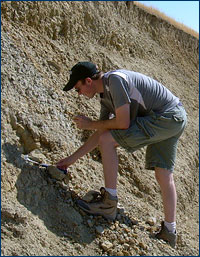 |
 |
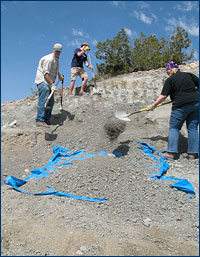 |

Left: Randy Irmis does some preliminary probing into a roadcut after finding some weathered fossil bone at the bottom of the slope. Right: The first step in excavating any quarry is to remove the rock that overlies the fossils — this rock is called the "overburden." Here, we remove several meters of overburden above the Hayden Quarry. Alan Turner (center) chops away at the hill face while Sterling Nesbitt (left) and Sarah Werning (right) shovel away the rubble. |
Looking for answers at the Hayden Quarry
Much ink is spilled on the subject of the extinction of the dinosaurs 65 million years ago. But rather than focus on the demise of these beasts, relatively few people have concentrated on the origin of the dinosaurs. Where did they come from? How did they diversify? Why were they more successful than some of their early contemporaries? When did dinosaurs first get big?
To help answer these questions, a team of graduate students from UCMP, the American Museum of Natural History, and the Field Museum of Natural History are excavating a new locality in northern New Mexico, called the Hayden Quarry. Located at Ghost Ranch, New Mexico, the area is better known as the inspiration for many of Georgia O'Keeffe's paintings. The quarry is found within rocks called the Chinle Formation, which was deposited as river sediments between 220 to 205 million years ago during the Late Triassic Period. The quarry is probably between 210 and 215 million years old.
The Hayden Quarry contains the remains of many different Late Triassic vertebrates, from fish to dinosaurs. Animals found include the large aquatic metoposaurid amphibians, crocodile-like phytosaurs, armored aetosaurs, bipedal early crocodilian relatives, and dinosaurs, among others. What is most exciting about the locality is that it contains a variety of true dinosaurs, as well as their closest relatives. Thus, we have preserved in the Hayden Quarry the transition from dinosaur precursors to true dinosaurs. By understanding how these species fit in the family tree, we can understand the timing of the diversification of the first dinosaurs and their relatives. When we compare the Hayden Quarry to other nearby localities with dinosaurs (for example, the Coelophysis Quarry), we can understand how long or fast it took for dinosaurs to go from being just another group to dominating the landscape.
The rock layers of the Hayden Quarry that preserve vertebrate specimens represent ancient river channel deposits. Thus, we find a variety of specimens, from isolated worn fragments to articulated skeletons. All of these were probably swept into the river channel during flooding episodes and subsequently buried. The team excavates these specific river channel rock layers to discover new fossil specimens.
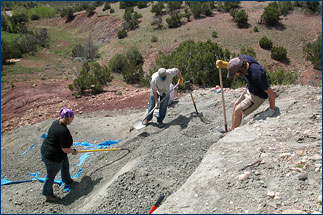 |
 |
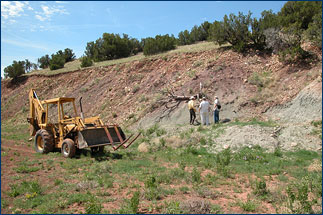 |

Left: Sarah , Sterling, and Alan hard at work removing overburden. Sometimes you need a more efficient method of removing overburden! Right: Virgil Trujillo, the Ghost Ranch Ranchlands Manager, Alex Downs the Ghost Ranch paleontologist, and Sterling Nesbitt discuss how best to use the backhoe at the Hayden Quarry. |
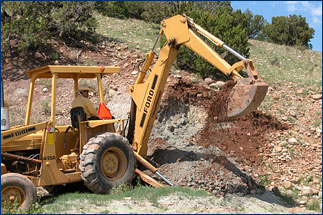 |
 |
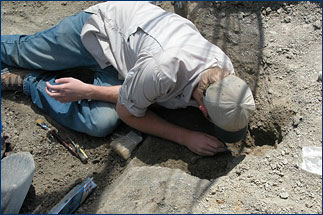 |

Left: Virgil and the backhoe make short work of the overburden removal. Right: The excavation of bones requires a finer approach. Sterling Nesbitt uses brushes and small picks to remove the rock around the femur (upper leg bone) of an early dinosaur. |
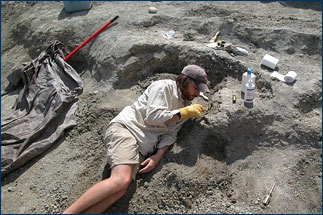 |
 |
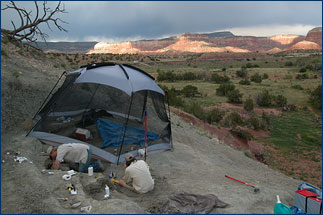 |

Left: Alan Turner excavates another bone. The bottles contain adhesive plastics dissolved in acetone — the crew uses this mixture to stabilize and glue broken bones. Right: Sterling and Alan continue excavating as an afternoon monsoon thunderstorm sweeps across nearby cliffs. |
Field procedures
The first step in field paleontology is to find a locality. You have to know where the bones are before you can excavate them! Most localities only have one or a couple of bones — rarely does a site have an associated skeleton. Localities such as the Hayden Quarry are extremely rare — very few places in the world contain thousands of bones of so many different animals in such a small area. In this case, the site was already found for us. It was discovered in 2002 by a hiker. We've been involved in excavating the Hayden Quarry since last year, when we found almost 1300 specimens in a five week period. Hopefully we'll match our success this year!
Very specific layers contain the bones, so the first step in this field season is to remove all the rock above these layers. This year we spent three days removing this rock with picks and shovels … with some help from a backhoe. We prepared a flat, stone surface that we can excavate in detail to find the bones. The bones in the Hayden Quarry can be microscopic or up to a foot or more in length. Therefore, we have to excavate very carefully. Common excavation tools include small brushes, awls, and dental picks. These allow us to remove the rock without damaging bones. Because the bones are very fragile, we often coat them with a thin coating of Butvar. This is an acrylic plastic that is dissolved in acetone so that it will penetrate the bones. To safely transport the bones back to the lab, we leave them encased in rock and surround them with a rigid cradle. For smaller bones, this cradle is made of medical bandages (like the ones that doctors put on your arm to immobilize a broken bone). Larger specimens are surrounded by strips of burlap soaked in plaster. A separating layer of damp toilet paper in between the bone and cradle keeps the plaster from permanently sticking to the specimen.
Early progress
This year, we had a stormy start to the field season, with several afternoons ruined by monsoon thunderstorms. However, the weather is now cooperating with us, so we're getting a lot done. We've already found a variety of new early dinosaur specimens, particularly leg bones. At current count, we've already excavated 400 bones — a great start! We also find a variety of other animals in the quarry, including phytosaurs, aetosaurs, and metoposaurid amphibians. There are also microscopic vertebrate fossils — most abundant are fish scales. We use a rather different method to recover these smallest of specimens, something that I'll talk about next time!







